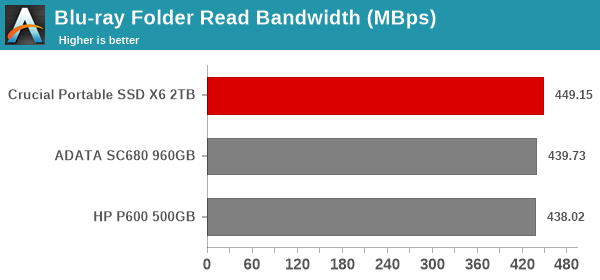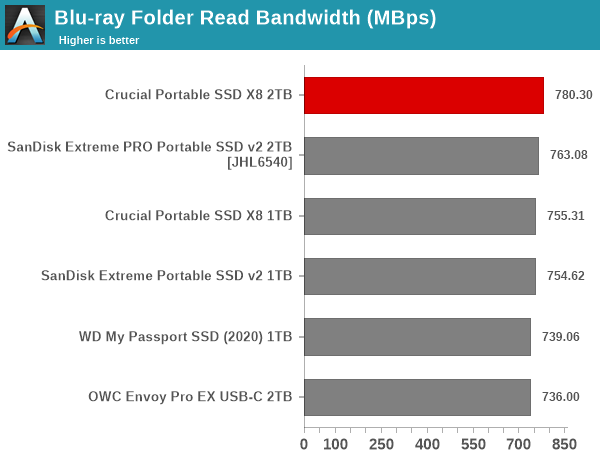Crucial Portable SSD X6 and X8 2TB Review: QLC for Storage On-the-Go
by Ganesh T S on October 21, 2020 8:00 AM ESTAnandTech DAS Suite - Benchmarking for Performance Consistency
Our testing methodology for DAS units takes into consideration the usual use-case for such devices. The most common usage scenario is transfer of large amounts of photos and videos to and from the unit. Other usage scenarios include the use of the DAS as a download or install location for games and importing files directly off the DAS into a multimedia editing program such as Adobe Photoshop. Some users may even opt to boot an OS off an external storage device.
The AnandTech DAS Suite tackles the first use-case. The evaluation involves processing three different workloads:
- Photos: 15.6 GB collection of 4320 photos (RAW as well as JPEGs) in 61 sub-folders
- Videos: 16.1 GB collection of 244 videos (MP4 as well as MOVs) in 6 sub-folders
- BR: 10.7 GB Blu-ray folder structure of the IDT Benchmark Blu-ray
Each workload's data set is first placed in a 25GB RAM drive, and a robocopy command is issued to transfer it to the DAS under test (formatted in NTFS). Upon completion of the transfer (write test), the contents from the DAS are read back into the RAM drive (read test). This process is repeated three times for each workload. Read and write speeds, as well as the time taken to complete each pass are recorded. Bandwidth for each data set is computed as the average of all three passes.

It can be seen that there is no significant gulf in the numbers between the different units for the read workloads. For all practical purposes, the casual user will notice no difference between them in the course of normal usage, though the X6 has a narrow lead. On the writes, we see the X6 getting penalized heavily. Power users may want to dig deeper to understand the limits of each device. To address this concern, we also instrumented our evaluation scheme for determining performance consistency, covered further down in this section.
Moving on to the NVMe-class drives, we again see a similar story being played out. There is not much separating the different drives' numbers, but writes definitely seem to be an Achilles heel for the X8.

The results are not surprising, given the QLC flash in the drive and the fact that Crucial has optimized the drive for read-intensive workloads.
Performance Consistency
Aspects influencing the performance consistency include SLC caching and thermal throttling / firmware caps on access rates to avoid overheating. This is important for power users, as the last thing that they want to see when copying over 100s of GB of data is the transfer rate going down to USB 2.0 speeds.
In addition to tracking the instantaneous read and write speeds of the DAS when processing the AnandTech DAS Suite, the temperature of the drive was also recorded at the beginning and end of the processing. In earlier reviews, we used to track the temperature all through. However, we have observed that SMART read-outs for the temperature in NVMe SSDs using USB 3.2 Gen 2 bridge chips end up negatively affecting the actual transfer rates. To avoid this problem, we have restricted ourselves to recording the temperature at either end of the actual workloads set. The graphs below present the recorded data.
| Performance Consistency and Thermal Characteristics |
 |
The first three sets of writes and reads correspond to the photos suite. A small gap (for the transfer of the video suite from the internal SSD to the RAM drive) is followed by three sets for the video suite. Another small RAM-drive transfer gap is followed by three sets for the Blu-ray folder. An important point to note here is that each of the first three blue and green areas correspond to 15.6 GB of writes and reads respectively. The X6 might not be the fastest drive when it comes to the writes, but, the consisntency maintained from run to run with both reads and writes is impressive. The temperature rise is only 2C after almost 250GB of traffic. The HP P600, though, fares better in both the thermal design and transfer rates perspective.
The same tests on the NVMe-class drives yielded the following results.
| Performance Consistency and Thermal Characteristics |
 |
The graphs for the X8 1TB and 2TB versions present interesting comparison points - In the 1TB version, we see writes with big hiccups in as soon as the second pass of the first workload. For the 2TB version, this doesn't happen until the third pass of the second workload. Devices such as the OWC Envoy PRO EX USB-C and the WD My Passport SSD maintain better consistency all through.










22 Comments
View All Comments
luxuryhousebuild - Wednesday, June 23, 2021 - link
At that point they will spend more hours requesting and examining many hard offers from exchanges to assemble a careful and exact financial plan. Given this time venture, it is commonplace for truly solid developers to be made up for their pre-development administrations. You can find an assortment of solutions to this inquiry; https://astorhomesbydesign.com.au/services/ interestingly, you feel great with the pay the manufacturer requests and with how they clarify their part in the pre-development measure for your task.Duncan Macdonald - Thursday, October 22, 2020 - link
This is QLC flash - most QLC will not reach beyond 1000 cycles - some will only reach a few hundred - the rated TBW IS important. Also the write speed on QLC often degrades as the cycle count increases.zepi - Thursday, October 22, 2020 - link
I don't care slightest about write endurance - I have hard time envisioning a use case where this kind of drive is written to death. Even few hundred P/E cycles is a lot for a normal person. If you are not a "normal person" and your workload is heavy, then go and buy something else.However, what I'd be very afraid is the data retention. QLC - drive being unplugged for reasonably long periods of time etc.
It is completely normal for people to take backups, transfer bunch of files etc. and expect them to be readable in half a year from writing after storing the drive in the glove compartment of their car or whatever crazy people do.
Is the data readable after such period? No idea.
AMDSuperFan - Thursday, October 22, 2020 - link
Ganesh - looking at the boxes in your picture they look pretty much banged up. Were these new or used drives that you tested here? I think you are an excellent writer.Oxford Guy - Monday, October 26, 2020 - link
"The emergence of 3D NAND with TLC and QLC has brought down the cost of such drives."You meant:
The emergence of 3D NAND with TLC has brought down the cost of such drives. QLC, meanwhile, is about increasing margin for drive makers and decreasing quality for consumers."
Oxford Guy - Monday, October 26, 2020 - link
"I don't care slightest about write endurance - I have hard time envisioning a use case where this kind of drive is written to death. Even few hundred P/E cycles is a lot for a normal person. If you are not a "normal person" and your workload is heavy, then go and buy something else. However, what I'd be very afraid is the data retention. QLC - drive being unplugged for reasonably long periods of time etc."Drive death in the consumer realm has always been mainly about firmware/controller bugs (or, possibly defective NAND), not the NAND wearing out through use. The most extreme examples I can think of are the Sandforce 2 controllers from OCZ that bricked drives when OCZ switched to 64-bit planar MLC (without telling anyone) and Intel's G2 drive that had a data corruption problem due to bad firmware.
(The Sandforce problem was never solved by a plethora of firmware patches. OCZ pretended that it solved the issue by letting people return the drives but the people who spent the most money (on the highest capacity drives, the 240 GB ones) were not allowed to return them! I have three bricked 240 GB OCZ drives. Two of them are drives OCZ sent when the first ones bricked.)
The differences between things like planar MLC and planar TLC have been about other problems. Planar TLC from Samsung didn't result in drive death (the red herring everyone talks about). Instead, it was voltage drift that caused the data to have to be constantly rewritten as a kludge "solution" to very poor performance. That much more frequent writing slows performance, makes one question the safety of storing the drive powered off for long periods, and can lead to the NAND wearing out I suppose.
Drive death from worn-out NAND has been a red herring for the most part, while other serious drawbacks to increasing the number of voltage states (by adding layers) have been whitewashed. Well, it looks like QLC brings back the drive death from worn-out NAND problem back a bit while having all of the drawbacks of there being so many more voltage states (which increases the problem of drift drastically).
The only things going for it is that it's 3D instead of planar and that capacities have increased which helps to mask the issue for most consumer workloads. Regardless, I consider QLC to be an unsatisfactory solution to a problem consumers didn't face: how to increase margin for the companies selling drives beyond what 3D TLC offers. That's the real driving force being QLC. It is not giving consumers a much better capacity deal for their money. The economy of scale factor, instead, works against consumer value by increasing the price of 3D TLC. Companies use that as an excuse to keep prices of QLC too high. Neat trick, for as long as they can make it last. By winding down TLC capacity, they can do it for as long as they like, so long as no one decides to fight the current and keep high volume TLC production going and reasonable pricing for it (in defiance of the scarcity dynamic).
happythanksgives - Tuesday, November 10, 2020 - link
Clearly, your Thanksgiving menu is critical, yet the event is a long ways past essentially stacking our plates. Thanksgiving is an occasion to exhibit your gratefulness for your partners, family, and all that you have for the duration of regular daily existence https://happythanksgiving2020.com/ . These true Thanksgiving proclamations will assist everyone with recollecting the clarification behind the season. This overview is overflowing with clever words that would make for an exceptional event toast or even as a respectable Thanksgiving engraving through online systems administration media.Henry jones - Monday, November 23, 2020 - link
I guess there is no need to compare 35$ product with the expensive onehttps://ynntechnology.com/product/dry-ice-machine/
iOSEmusapps - Monday, March 15, 2021 - link
It is seen as that getting changed applications is very irksome in iOS, yet iOSEmus simplified this dazzling. It has a whole library of the https://iosemus-app.com/ relative multitude of top notch applications that can fulfill you truly particularly perky. Do whatever it takes not to confide in me? I BET you should endeavor this.mp3pawtv - Monday, July 5, 2021 - link
Mp3Paw Download Free Mp3 Music in High Quality – Can I download free MP3 Music from MP3PAW or how might I will download Free films from MP3paws? https://mp3paw.tv/ Here in this article, you would have the option to gain proficiency with a ton about the mp3 paw download and furthermore how to get to the mp3paw download page to download the decisions of your Mp3 music melodies.